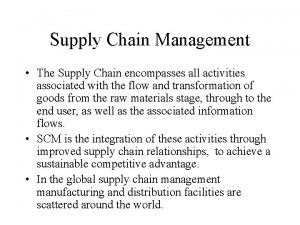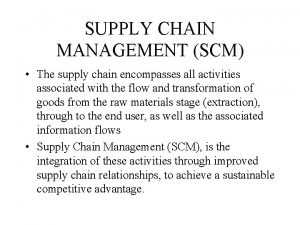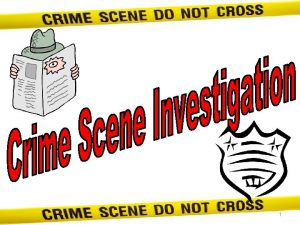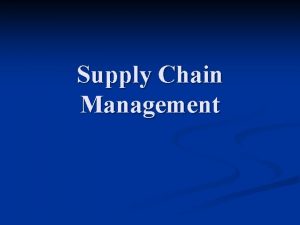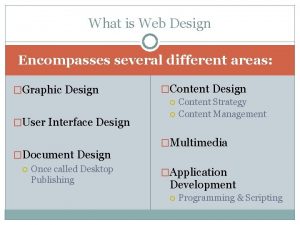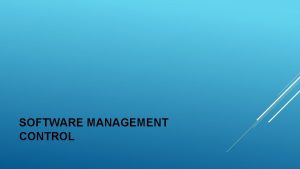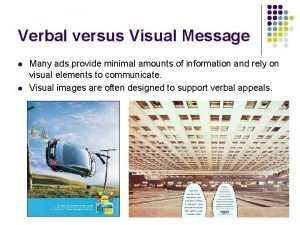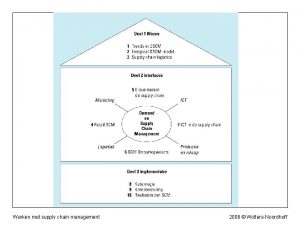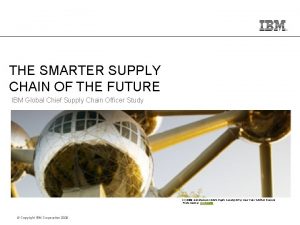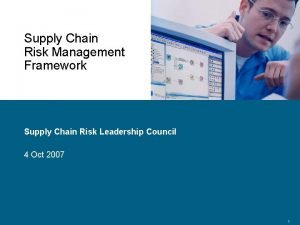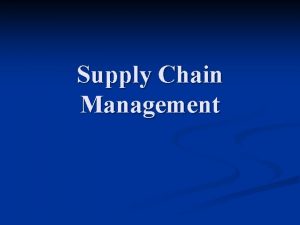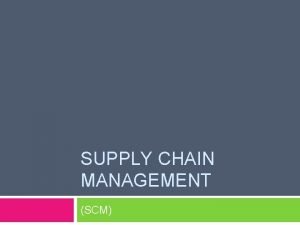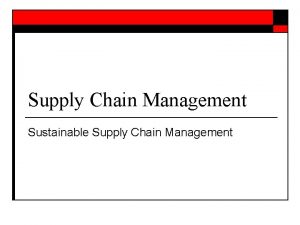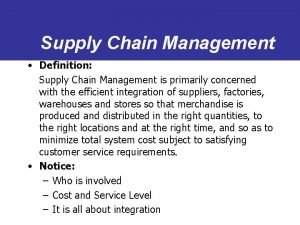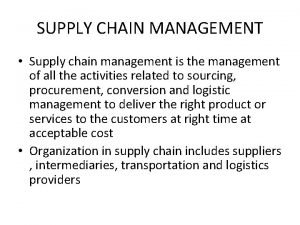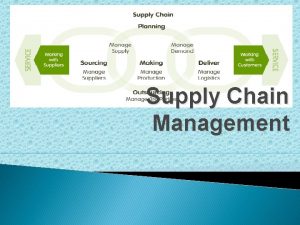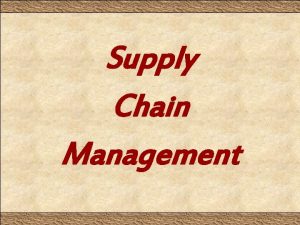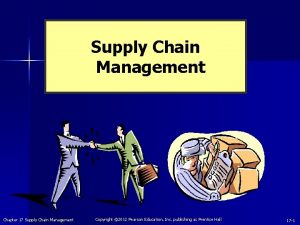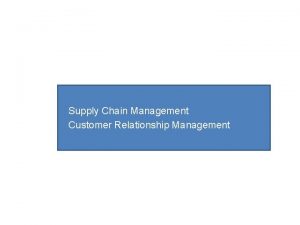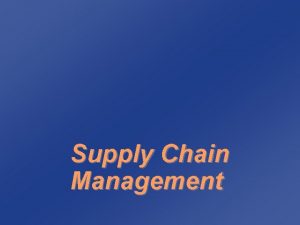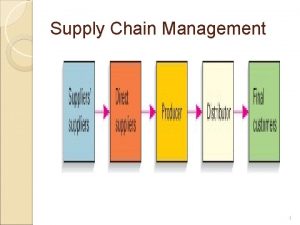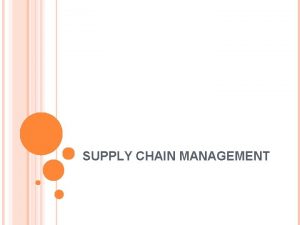Supply Chain Management The Supply Chain encompasses all




















- Slides: 20

Supply Chain Management • The Supply Chain encompasses all activities associated with the flow and transformation of goods from the raw materials stage, through to the end user, as well as the associated information flows. • SCM is the integration of these activities through improved supply chain relationships, to achieve a sustainable competitive advantage. • In the global supply chain management manufacturing and distribution facilities are scattered around the world.

Linear Supply Chain • Downstream flow (flow of physical goods): supplier, manufacturer, wholesaler, retailer. • Upstream flow (flow of demand information): retailer, wholesaler, manufacturer, supplier (purchasing managers are responsible for ensuring that the right suppliers are selected, they are meeting performance expectations, appropriate contractual mechanisms are employed, and a good relationship is maintained).

laptop: P. Cereal A Cereal Manufacturer’s Supply Chain Grain Cereal P. Cereal g. store farmer processing packaging distributor Paperboard Corrugated manufacturer Labels Wood Lumber Co Label manufacturer customer

Inventory Management Across the Supply Chain • “Perfect orders” are demanded • The reduction of delivery times both in the marketplace and through the supply chain (Hewlett-Packard, Toyota, Xerox are called “timebased competitors”) • Customers award their business to time-based competitors because they can reduce their inventory levels while saving time and money.

Supply Chain Relationships • Develop a better understanding of suppliers’ processes, suppliers’ quality and their delivery performance. • Establish communication links with customers and suppliers and utilize those links on a regular basis. • Introduce an objective performance measurement system. • Improve trust between buyers and suppliers by improving communication, joint problem solving projects, training seminars on sharing corporate philosophies (eliminate nonvalue added processes)

Challenges Facing SCM • Implementation of an integrated supply chain is very difficult. • Very often information systems differ and supply chain members are reluctant to share information. • Delays in shipments due to customs, adverse weather patterns, poor communication and human error.

Three Main Aspects of SCM • SCM as a cross-functional entity • SCM as a strategic user of inventory and other production resources (balancing demand & capacity) • SCM as the integrator and coordinator of production and logistics activities. This approach is the essence of the SCM and it helps to achieve operational efficiency with regard to cost, lead times, and customer service.

The Bullwhip Effect in SCM • Orders to the upstream member in a supply chain exhibit greater variance than actual orders at the point of retail sale (demand distortion) • The variance of orders increases as one moves upstream (variance propagation)

Four Causes of the Bullwhip Effect • Demand forecast updating • Order batching • Price fluctuations (P&G and Motorola programs to stabilize prices and smooth demand patterns) • Rationing within the supply chain (Motorola rationing scheme)

Examples • A supply chain for processed cereal begins with grain, sugar cane, and other ingredients growing on farms. In 1995 it took 104 days (over 3. 5 months) for a typical box of cereal to make its way from the manufacturer to the grocer’s shelf. • In the apparel industry it takes 58. 5 weeks for a typical dress to get to the customer (only 15 weeks are in-process inventory ).

Examples (continued) • The Limited and Benetton use tighter supply chains and faster replenishment of products to eliminate unnecessary inventory, stockouts, and markdowns. • The Hewlett-Packard (HP) Deskjet printer was able to reduce its inventories within the Vancouver factory from 3. 5 months to. 9 months.

Avoiding the Bullwhip Effect • • Access to market demand information (use Pos data) Information sharing across supply chain links (use EDI) Vendor Managed Inventory (VMI) Lead time reduction and JIT supply Reduction of processing costs (use CAO) Use third party logistics Reduce frequency and magnitude of special deals and consumer promotions • Use Continuous Replenishment Program (CRP) • Use better product allocation policies • Apply penalties on order cancellations

Interorganizational Information Systems (IOIS) • IOIS are systems based on information technologies that cross organizational boundaries. • The foundation of the IOIS is the ability to share information within the supply chain. • IOIS is an integrated data-processing/datacommunication system utilized by two or more separate organizations.

Advantages of an IOIS • Cost reductions • Productivity improvements • Product/market strategy

Software Applications Pertinent to SCM • Base Rate, Carrier Select, and Match Pay developed by Distribution Sciences, Inc. (compute freight costs, compares transportation mode rates, analyzes cost and savings effectiveness of carriers) • Supply Chain Planning by Ross Systems, Inc. (end-to-end enterprise resource planning)

Other Technologies in SCM • Bar coding/scanning (Wal-Mart, Fed. Ex) • Data warehouses (a data warehouse is a consolidated database maintained separately from an organization’s production system databases: for example, tracking sales and coupon mailings) • DSS (Decision Support Systems)

Specific Technologies for an Effective DSS • • • SQL interface Expert system rules Scheduling algorithms Linear programming algorithms Blocked scheduling Graphical user interface (GUI): custom windows, dialog boxes, pull down menu, etc. • Demand management • User definable database (object oriented approach)

International Considerations • Greater geographic distances and time differences • Added forecasting difficulties and inaccuracies • Multiple national operations locations (exchange rates and other macroeconomic uncertainties) • Infrastructural inadequacies ( worker skills, supply availability and supplier quality, lack of local process equipment and technologies, inadequacies in transportation and telecommunication infrastructure) • Explosive dimensions of product variety in global markets (computer products build with different supply modules, e. g. local voltage, keyboards, manuals, etc. )

Vertical Integration (VI) and Local Suppliers (LS) • Country environment (market size and growth, labor cost, labor skill, local managerial capacity, political risk, import controls, cultural compatibility) • Competitive situation (industry concentration, relative competitive strength) • Company characteristics ( see pages 228 and 229 in the textbook)

Additional Costs Associated with Global SCM • • Manufacturing costs Movement costs Incentive costs and subsidies – taxes & subsidies Intangible costs – quality costs, product adaptation or performance cost & coordination • Overhead costs – total current landed costs • Sensitivity to long-term costs – productivity and wage changes, exchange rate changes, product design, core competence.
 What encompasses all activities associated with the flow
What encompasses all activities associated with the flow A encompasses all activities associated with the flow
A encompasses all activities associated with the flow The biosphere encompasses all of the
The biosphere encompasses all of the Vocabulary crime scene
Vocabulary crime scene Crm vs scm
Crm vs scm Enterprise resource planning ppt
Enterprise resource planning ppt The sequence of a typical supply chain is
The sequence of a typical supply chain is Matching supply and demand in supply chain
Matching supply and demand in supply chain It encompasses several different aspects including
It encompasses several different aspects including Describe shampooing for wheelchair bound clients
Describe shampooing for wheelchair bound clients English cuisine encompasses
English cuisine encompasses Dfld radar
Dfld radar Verbal ads
Verbal ads Name three line segments
Name three line segments Difference between logistics and supply chain
Difference between logistics and supply chain Food chain sequence
Food chain sequence Werken met supply chain management
Werken met supply chain management Ibm smart supply chain
Ibm smart supply chain Supply chain risk management framework
Supply chain risk management framework Supply chain risk management framework
Supply chain risk management framework Supply chain cisco
Supply chain cisco
